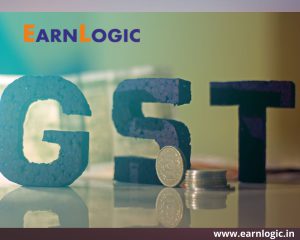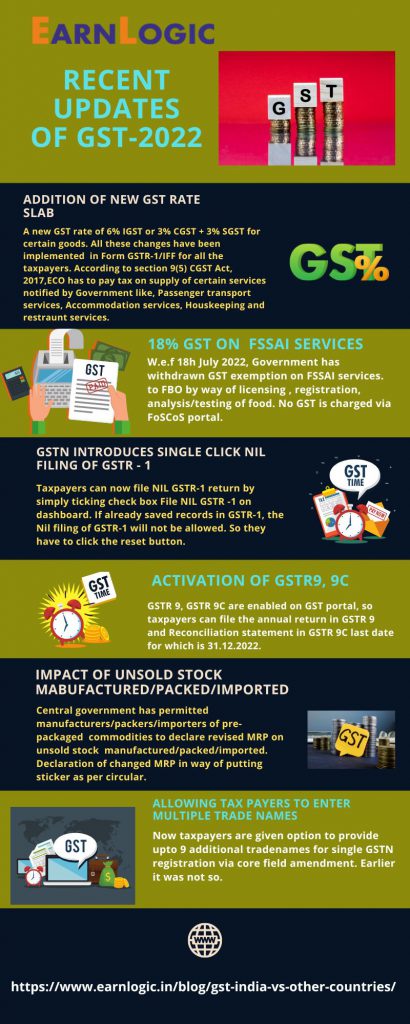The idea of the GST is first presented in France in 1950s by a French tax official. From that point forward, numerous different nations took on GST similarly however some acknowledged it in VAT for example Value Added Tax form. Today, in excess of 160 countries including the European Union and Asian nations are practicing this type of tax collection. Besides, Countries like Sri Lanka, Singapore, and China additionally sharing the hand in the training.
On a harsh note, 90% of the total populace live in nations with VAT or GST as the tax collection system. The GST council settled the tax rates on 80-90% of the labor and products under the 4 piece form keeping fundamental things of everyday use in the most reduced section of 5%. India, sadly, came into this system very late.
Introduction of GST in India
The GST that is registered by GST registration in Chennai is a sort of sales tax levied on the utilization of labor and products. It replaces around 16 tax levies 7 central taxes like excise duty and service tax and 9 states tax like value added tax. And entertainment tax restricting India as one market with one tax rate.
GST was a Game changer on the lookout and in the event that we contrast the proficiency acquires under VAT and the GST, it has given the higher tax lightness and an improvement in government finance over the medium term.
GST was first presented in 1985, by Vishwanath Pratap Singh and it was carried out in 1999, 2002, 2005, 2011 and in 2017 it was at long last presented. On 7 July 2017, the whole country got the insight about the executed tax assessment system called the GST for example Merchandise and Service Tax. The GST committee has set the assessment rates for service and goods under 5 sections of 0%, 5%, 12%, 18% and 28%.
What is GST in India?
GST Registration done by GST registration in Chennai is applicable if the supply turnover of all Indian specialist organizations, including a wide range of consultants along with sales and makers crosses Rs.20 lakh, since first April 2017.
Why GST has execution in India?
- To track down the method of proficient tax collection
- Ease in Interstate and intrastate development of service and goods
- Decrease in Corruption
- To decrease the tax avoidance
What is the Difference between GST in India versus GST in different Countries?
One of the significant contrasts between GST in India and GST in different nations is that in India GST is taxed under two Government specialists. As on the grounds that India is a bureaucratic country with both the Center and the State wherein the two has the power to tax and gather taxes as per the suitable regulation. Both the Central and State Government has various duties to perform as per their own power as has been endorsed in the Constitution. The three taxes material under the GST are:
CGST – Tax collected by Central Government on intra-state sale.
SGST-Tax collected by State Government on intra-state sale.
IGST – Tax collected by State Government on between state sales
- There are two primary types of GST in India for example CGST and IGST. Different nations have an incorporated GST system.
- Not likely different nations, India has not a similar rate of GST that is registered by GST registration in Chennai.
- India tax collection system is stacked with rules and guidelines for the execution of GST. Though, GST designs of different nations like Canada, New Zealand is very straightforward and straightforward.
- Methodology for filing the tax and paying sum is complicated than the other nations.
- “Sin Tax” is carried out in uncommon circumstances.
- GST that is enrolled by GST registration in Bangalore is a uniform design yet with little complexity and disarray than some other nations.
GST in India versus GST in different Countries
Presently, coming to the definite clarification of the Countries,
GST in India versus GST in New Zealand
GST in New Zealand was quick to come into light in 1986 at a rate of 10%. Nonetheless, the rates are changed two times in the year 1989 with 12.5% and 15% in 2010 to produce higher income while eliminating contortions in the assessment form.
Besides, this change prompted the reception of GST at a solitary rate remembering nourishment for the GST base at the full rate. Thus, such expansive based the tax net and furthermore decreased both consistence and managerial taxes. By and by, the nation is getting the most assessment useful countries among the OECD nations.
GST in India versus GST in Canada
Discussing the Canada GST system, it was a staggered VAT in 1991 on the provisions of labor and products bought in the country. The GST incorporates practically every one of the items in it barring specific basics like food, private lease, and medical benefit.
Moreover, the bill once gets executed then it will be directed to new handling tasks and strategies to check the precision of the return presented by little business people. Notwithstanding, Canada forces its own sales tax other than GST.
The GST rate in Canada is 5% on the provisions of labor and products and in some region, there is a blended sales tax at 15%.
GST in India versus GST in Singapore
The nation presented the GST bill in April 1994 at a tax rate of 3%. The expectation was to make the public acknowledgment to people in general and to limit expansion. The government committed to the public not to raise the tax for the following 5 years that came in as a significant choice in resuscitating purchaser spending. With Effect from 2007, the GST rates have been expanded to 7% that still extremely less contrasted with GST rates of India.
GST in India versus GST in Indonesia
Presently, in Indonesia imports are generally dependent upon VAT and GST, however a large portion of the products are excluded from its rundown. The tax rate in Indonesia is 10% in the event that the services are provided external the boundaries of Indonesia, at times, the specific thing is taxed at 20% with a cap of 35%.
Pushing ahead to the extravagance things the assessment rate is appropriate to the import around 10% to half. The greater part of the things like gold, mining items, expressions and amusement, schooling, protection, stopping or public vehicle, work, medical wellbeing, food, and refreshment served in lodgings are not expose to pay any VAT.
GST in India versus GST in China
While we discuss GST in China, then, at that point, perhaps we can make a conjecture, why China is a decent player on the lookout. GST in China is charging tax rates at 0%, 5% and 19%.
GST in India versus GST in Australia
In Australia, the GST is a government tax collected by the preeminent power and afterward separated further among the states with no clash of words at the hour of a process. The GST was presented in 2000 with the tax rate of Rs 10% which is as yet steady at today date.
GST in India versus GST in the USA
We as a whole realize the US is a bureaucratic republic country where taxes are collected at a different level from the administrative, state or nearby government. In the US, the government tax rates are somewhere in the range of 10% and 39.6% of available pay. The state or nearby government is charging tax from 0% to 13.30% of the absolute available pay.
GST in India versus GST in U.K
There are three assessment rates for example 0%, 5% and 20% relevant to labor and products. The vast majority of the products are covered under 20% tax rates. The VAT on the stamps postage, monetary property exchanges, food and kids’ garments are excluded things.
GST in India versus GST in Brazil
The most autonomous and light-hearted GST system when contrasted with other is GST in Brazil. It has split rules of taxes between the states and the middle. Brazil has 6 tax chunks which are as per the following 0%, 1.65%, 2%.7%, 12% and 17%.
GST in India versus GST in France
The country who presented the GST is France. The GST has executed in France, right off the bat, in 1954 with 4 tax rate pieces. The rates in this province are taxable in the piece rates of 2.1%, 5.5%, 10%, and 20%. Among the Tax rates, 20% is the standard rate pertinent to the majority of the products in France.
GST in India versus GST in Ukraine
GST in Ukraine, a standard rate of tax applied at 20% and the VAT value is added to the tax of labor and products cost. There are a portion of the provisions that are likewise dependent upon the lower rates under 0% and 7%.
For the most part, GST at 7% rate is material to drugs items, medications, and medical gear though % VAT is on the product of labor and products.
GST in India versus GST Malaysia
GST was carried out in Malaysia with impact from 1 April 2015 with the predictable rate of 6%. Here, Sales tax and service tax are ordered by various tax rates which are 10% and 6% individually. A portion of the things like channeled water, the initial 200 units of power each month, transportation services, and parkway cost and wellbeing service are excluded from tax collection.
The purpose for the double GST model in India
After the US, India is likewise a government country where both the middle and the states have doled out the ability to demand and gather the taxes through suitable regulation. The Dual GST model comprises of Central Goods and Service tax (CGST) and State Goods and Services Tax (SGST) rates. The GST can be registered by GST registration in Bangalore.
In India, both the middle and State have allotment with the ability to impose and gather tax through suitable regulation. Besides, the middle and state government play various parts and duties to perform seeing the division of force recommended. A double GST has in this way lined up with the sacred necessity o9f fiscal federalism.
The progress of the Implication of GST in India
No Rise of Inflation
It was expected that GST which is registered by GST registration in Bangalore would cause high expansion in a market likewise with numerous nations have seen it. Be that as it may, it doesn’t occur tragically in India. The counter exploitative power assisted enough with guaranteeing that organizations didn’t get misuse the change.
Single National Market
With the destroyed of the check post, the long line of the truck at state line lost to locate making a consistent public market. The long line had confined the development and prompting tremendous postponements and expanding exchange costs for the strategies area.
Uniform Tax
A customer in Karnataka will pay a similar tax on a thing as one in Delhi. GST that has registration by GST registration in Bangalore has permitted the organizations to follow the circulation system creation, production network, capacity. The system assists with making them more productive keeping state tax I mind.
Increase number in Registration
Comparing with the old circuitous tax system there is a precarious expansion in the enlistment under the GST system. The review express that Registration under old roundabout assessment system is around 6.4 million and in GST it crosses 11.2million.
Filing Tax Return
The quantity of income tax return filing has expanded from the year before. How much government form filing in F.Y in 2017 is around 5.43cr where it is determined 6.84cr in F.Y.
Simple GST Return file
The most compelling motivation for the outcome of GST registered by GST registration in Coimbatore is its disentanglement. The government occasionally takes drives to make it all the more simple and solid for a client.
Effect of GST in India
Complex Compliances
Complex compliances make GST that is registered by GST registration in Coimbatore more challenging to share. The data innovation misfires take additional time than the expected opportunity to determine any issue. Another GST return filing form is to help and make the interaction considerably less complicated for organizations.
Cess on SIN products – Undoubtedly, GST has rejected a variety of duties and cess yet it likewise has presented another toll as remuneration cess on extravagance and sin merchandise. This will later have extension to cover cars.
Conclusion
At last, in all cases GST that is registered by GST registration in Coimbatore rates are taxed between 16 to 20% and India has some place takes the tips from this and put down in a comparative example. Likewise, the normal Indian Economy development with the GDP has an extraordinary speed. As the guessed taxpaying local area is probably going to get a development of 5 to multiple times than the ongoing economy before very long.


